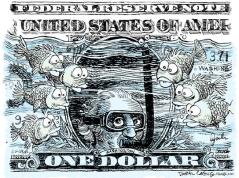G20 Nations Slam Quantitative Easing
November 8, 2010
Emerging nations also take measures to avoid currency valuation against the purposely concocted fall of the dollar.
Reuters
U.S. President Barack Obama defended the Federal Reserve’s policy of printing dollars on Monday after China and Russia stepped up criticism ahead of this week’s Group of 20 meeting.
The G20 summit has been pitched as a chance for leaders of the countries that account for 85 percent of world output to prevent a currency row escalating into a rush to protectionism that could imperil the global recovery.
But there is little sign of consensus.
The summit has been overshadowed by disagreements over the U.S. Federal Reserve’s quantitative easing (QE) policy under which it will print money to buy $600 billion of government bonds, a move that could depress the dollar and cause a potentially destabilising flow of money into emerging economies.
“I will say that the Fed’s mandate, my mandate, is to grow our economy. And that’s not just good for the United States, that’s good for the world as a whole,” Obama said during a trip to India.
“And the worst thing that could happen to the world economy, not just ours, is if we end up being stuck with no growth or very limited growth,” he said.
European Central Bank President Jean-Claude Trichet said all participants at a meeting of the world’s central bankers in Basel, Switzerland had insisted they were not pursuing weak currency policies.
“We’re attached to avoiding excessive volatility. It’s very counterproductive for global growth and global stability,” he told a news conference.
Washington has frequently criticised China, saying it deliberately undervalues its currency to boost exports.
China says the United States, via the Fed, is engaged in the same thing that it stands accused of, and some emerging nations have already acted to curb their currencies’ rise.
Resentment abroad stems from worry that Fed pump-priming will hasten the U.S. dollar’s slide and cause their currencies to shoot up in value, setting the stage for asset bubbles and making a future burst of inflation more likely.
“As a major reserve currency issuer, for the United States to launch a second round of quantitative easing at this time, we feel that it did not recognise its responsibility to stabilise global markets and did not think about the impact of excessive liquidity on emerging markets,” Chinese Finance Vice Minister Zhu Guangyao said on Monday.
The Fed’s quantitative easing policy was unveiled last week to jeers from emerging market powerhouses from Latin America to Asia. Russia renewed its assault on Monday.
“Russia’s president will insist …. that such actions are taken with preliminary consultations with other members of the global economy,” said Arkady Dvorkovich, a Russian official who is preparing the country’s position in Seoul.
Bank of Japan Deputy Governor Hirohide Yamaguchi said on Monday that it too was ready to boost its asset-buying scheme if it saw clear signs of a downturn. Worth 5 trillion yen ($62 billion), it is so far just a tenth the size of the Fed’s.
U.S. DROPS KEY DEMAND
India is Obama’s first stop in a 10-day trip to Asia that will include Indonesia and Japan.
He will arrive in Seoul for the Nov. 11-12 summit weakened by a crushing congressional election defeat for his Democratic Party and under fire from all sides. Germany described U.S. economic policy as “clueless” last week.
The U.S. has already all but dropped its centrepiece proposal for the G20 — a measure that would cap current account balances at 4 percent of gross domestic product, something economists said was clearly aimed at China.
At the weekend, U.S. Treasury Secretary Timothy Geithner backed away from the numerical target that had been rejected by China, Germany, Japan and others in a sign that global financial power had slipped from U.S. hands.
On Monday, he was putting on a brave face, saying China was supportive of the G20′s framework for rebalancing the global economy, and that he expected broad consensus on it at the summit.
The risk of a negative outcome in Seoul appears to be increasing, or at the very least, an agreement that merely papers over the huge gaps and allows countries to pursue their own economic policies whether it be intervening in currency markets like South Korea and Japan or printing dollars.
“Judging by the critical response of emerging market governments to QE, the likelihood of a ceasefire in the currency war is slim,” RBC Capital markets said in a report published on Monday.

